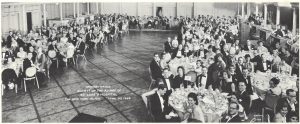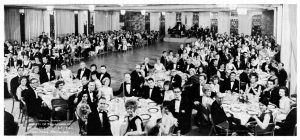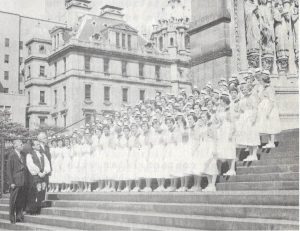In years past, as the weather warmed up, the staff and alumni looked forward to renewing old acquaintances and socializing with colleagues from across the hospital’s departments. This blog post will highlight the three main traditions of spring, mention their roots and how they evolved.
The first event was the annual alumni dinner, which gathered all the graduates of the Resident training program together to enjoy a good meal, good conversation, and informative lectures. The Society of the Alumni of St. Luke’s Hospital of New York City was established in 1891 and was formed with the intent to “foster collegiality and scientific discourse and to honor accomplished colleagues at an annual dinner.”

The image above, taken from the News of St. Luke’s newsletter, depicts the dinner held on April 30, 1965, at the New York Hilton Hotel.

This photo memorializes the St. Luke’s 1973 alumni dinner at the 7th Regiment Armory.
In 1896, Roosevelt Hospital ‘ex-interns’ met at the hospital to plan the twenty-fifth anniversary of its opening and organize The Roosevelt Hospital Alumni Association. Its stated purpose was “…maintaining loyalty to the institution and promoting its broader usefulness.” Unfortunately, the Archives does not have any photos documenting their celebrations over the years.
Every June during the 1960s, St. Luke’s Attendings invited the Residents to join them for a “Field Day.” Held at New Jersey’s Englewood Country Club, the usual barriers of position, age, and authority were ignored during an afternoon of hotly contested athletic events (softball, golf, and tennis, swimming, etc.), followed by a casual dinner and evening entertainment.
Evening offerings were often films created by actor/director wannabes, Drs. Harry Roselle and Theodore Robbins and the various colleagues they could round up to help. One year’s offering was a Dr- Kildare-meets-Dracula-at-St.-Luke’s horror flick titled, “Anemia of Uncertain Origin.” Another was a spy thriller á la a 1960s TV comedy favorite titled ‘Get Smart,’ called “Aardvark,” in which Secret Agent 95.6, battled Aardvark, a Fu Manchu-type enemy who developed an infamous blood sludging device.
Each year’s outing was documented with a panoramic photograph of attendees. These photos, usually between four and six feet long and about ten inches high, have proven to be a challenge to store in the Archives. About ten of them arrived, each individually tightly rolled. They required re-humidifying in a makeshift humidification tank in order to relax the paper enough to allow them to be flattened for storage. They are available for viewing for those who wish to walk down memory lane.
In case you, dear reader, are curious, the Field Day photo was cut in two in order to be printed in the former newsletter, The News of St. Luke’s. The images used here were scanned from the newsletter because the originals are too large to fit on current in-house scanners. It may also be of interest to note that the dinner photographs, whose originals are two to three feet long and eight to ten inches high, were taken with a fish-eye camera, which has curved lenses to allow the whole room to fit into one image. The author is not sure what equipment was used to capture the huge Field Day images.


Unfortunately, one year in the early 1970s the event was cancelled due to unforeseen circumstances, and it was not picked up again in the following years.
The final big spring event for many years was the St. Luke’s Hospital School of Nursing graduation ceremonies held at the Cathedral of St. John the Divine, just south of the Hospital. Nursing students would line up at the Hospital and proceed down Amsterdam Avenue, marching up the front steps to enter the Cathedral and take seats at the front while their families observed the ceremonies from behind them. At the end of the ceremonies the graduating class would pose for a group photo on the Cathedral steps.




The above images, taken from the News of St. Luke’s newsletter, are of the graduating class of 1955; the image below shows the graduating class of 1974, the year the St. Luke’s Hospital School of Nursing program closed its doors and merged with the Columbia University School of Nursing Bachelor of Science program.

Roosevelt Hospital also had a School of Nursing, founded in 1896. At first, students were accepted on a rolling admission any time, and as students successfully completed the required coursework, diplomas, graduate caps and pins were awarded with little fanfare in the Administration Building. By the 1920s a formal cycle of classes developed, and graduation was set at a fixed time of year. At first, ceremonies were held in the Syms Operating Room, and later, as the number of students grew, the ceremony was moved to a hotel ballroom. Unfortunately, the Archives does not have images from the Roosevelt Hospital School of Nursing graduations, and like St. Luke’s, the hospital-based school also closed its doors in 1974, but the Alumni Association is still fairly active and enthusiastic about staying connected.
Michala Biondi for the Aufses Archives.
